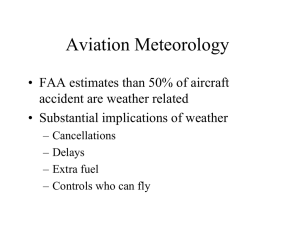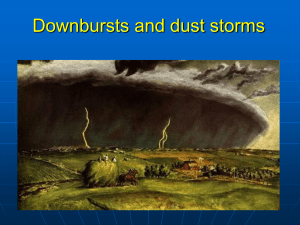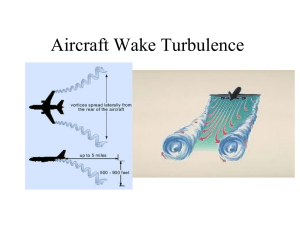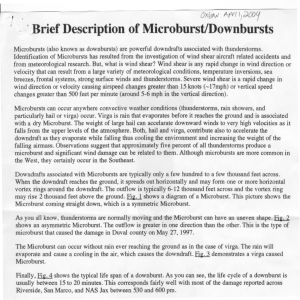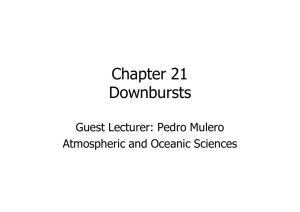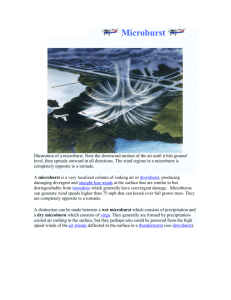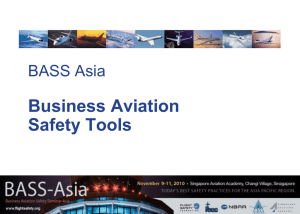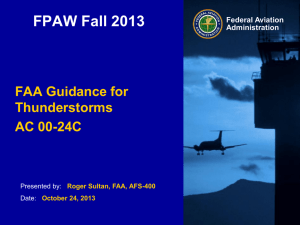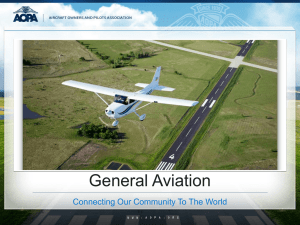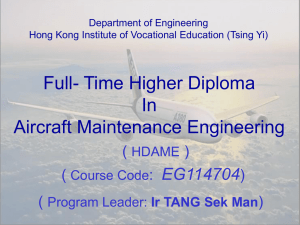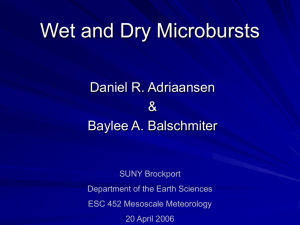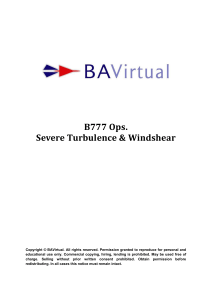Microbursts
advertisement
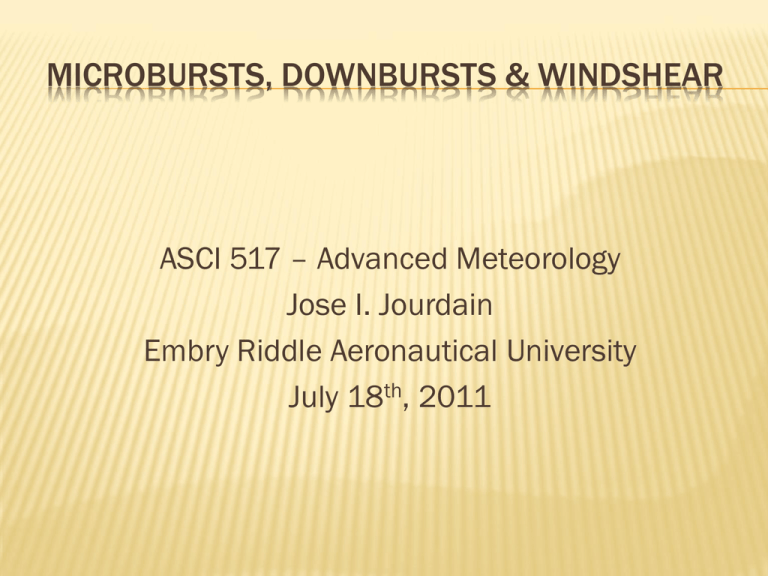
MICROBURSTS, DOWNBURSTS & WINDSHEAR ASCI 517 – Advanced Meteorology Jose I. Jourdain Embry Riddle Aeronautical University July 18th, 2011 For the subject at hand a brief definition of each phenomenon will be provided hereunder, so that the reader can be better familiarized with the terms which will be rendered during the course of this presentation. Downbursts: Can be defined as localized downdrafts located under thunderstorms. Microbursts: Can be defined as downbursts with winds extending 4 kilometers or less. Macrobursts: Can be defined as larger downbursts with winds extending more than 4 kilometers. IMPACT OF PHENOMENON ON AVIATION This phenomenon is of particular importance to aviation due to the inherit risks it poses on aircrafts: During takeoff During landing The short time for pilots to react once detected. Are also responsible for damages to objects on the ground, such as large as trees It can occur in basically all types of conditions, such as dry or humid regions, as well as in thunderstorms or even clouds that may not contain thunder and lightning CHARACTERISTICS Microbursts Are characterized by downburst winds of four kilometers or less. Nevertheless, despite its small size, the concentration of localized wind can reach as high as 168 miles per hour (146 knots). The leading edge of a microburst can evolve into a gust front (Ahrens, 2009). Macrobursts Are larger downbursts that extend more than four kilometers. The rapid changes in wind speed and wind direction is commonly referred to in aviation as “windshear”, and has been a direct contributing factor of multiple airline accidents MICROBURST / WINDSHEAR IMAGE FIGURE 1-1 Microburst/Windshear Image Rendering Source: Courtesy of NASA (2010) AIRCRAFT TRAVERSING WINDSHEAR The basic characteristics of an aircraft traversing a microburst “windshear” is: An initial outflow on the front side, which increases the headwind component, causing the airplane to rise and its indicated airspeed to increase. Several seconds later, the headwind component begins decreasing and the airplane traverses the central core downdraft, which can be very strong. Finally, the airplane encounters the back side of the microburst, and the tailwind component begins to increase, causing the airplane to sink and its indicated airspeed to decrease (Fujita, 1981). The previous slide indicates that pilots obviously do not have a very long time to adjust, and can therefore create serious performance problems for an aircraft. If we assume the data that the microburst’s horizontal outflow winds are 30 knots, then during the 20 to 40 seconds required to traverse the area, an airplane would encounter a 60-knot horizontal windshear. DOES IT AFFECT AVIATION? The microbursts and downbursts phenomenon affects all types of aviation, military or commercial, and regardless of aircraft type. As previously discussed, it can occur in any region and it’s not limited only to severe thunderstorms. According to ICAO statistics, between 1970 and 1985, there were 28 aviation accidents with 700 fatalities caused by low level microbursts “windshear”. As follows, qualitative support of accidents caused by this phenomenon will be put forth as direct examples of how the phenomenon affects aviation: On August 2nd, 1985; one of the most well known accidents attributed to this phenomenon, the Delta Airlines flight 191 which crashed during landing at Dallas Fort Worth, Texas. On July 9th, 1982; a Pan American World Airways Boeing 727 crashed after encountering a microburst shortly after takeoff. One hundred forty five passengers and eight persons on the ground were killed in Kenner, Louisiana (NTSB, 1981). On June 24th, 1975; a Boeing 727 crashed during approach to JFK International Airport. 115 passengers killed (NTSB, 1976). On July 07th, 1980; a Tupolev 154B-2 crashed as it climbed from Almaty Airport at Kazakhstan. 163 passengers killed (NTSB, 1981). MITIGATION OF PHENOMENON It wasn’t after the crash of Delta Airlines flight 191 in 1986, which captured and concentrated a great deal of spotlight on this phenomenon that serious steps were made. Once the official findings were published, which according to the NTSB’s executive summary report (AAR-86/05, 1985), the accident was attributed to: “The lack of ability to detect microbursts aboard the aircraft; the radar equipment aboard aircraft at the time was unable to detect wind changes, only thunderstorms”. These statements proved to be the catalyst so that a serious solution would be found. After the formal investigation from the NTSB was concluded, NASA researchers at Langley Research Center took the initiative of: Modifying a Boeing 737-200 and adapting an on-board Doppler Weather Radar. This experiment resulted in the creation of the “airborne wind shear detection and alert system”. Subsequently the Federal Aviation Administration mandated that all commercial aircraft must have on board wind shear detection systems. REFERENCES Ahrens, D. (2009). “Thunderstorms & Tornadoes”. Meteorology Today, p. 377, 378 Fujita, T.T. (1981). "Tornadoes and Downbursts in the Context of Generalized Planetary Scales". Journal of the Atmospheric Sciences, p. 38 NTSB (1985). “Aircraft Accident Report”. AAR-86/05 NASA (2010). “Windshear Illustration”. Taming the Microburst Windshear.
